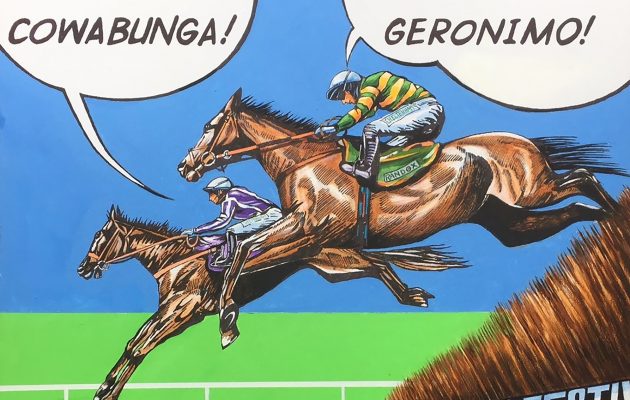Dee Taylor combines the pop-art of Lichtenstein with the colour of the racecourse to winning effect, as he explains to Janet Menzies
Having discovered racing as an ideal subject for pop art, Dee Taylor tells Janet Menzies how Roy Lichtenstein and comic books have inspired him.
For more sporting artists, Oliver Akers Douglas is engaged by the sporting scene just before it springs to life. And Michelle Pearson Cooper is bringing the same respect we have for big cats to domestic dog portraiture.
DEE TAYLOR
How often have you texted a racing friend to say: “I’m in the Royal Enclosure… where are you?” But did you realise that the reason she’s a no-show is because she is actually a mermaid? In the comic-book world of Dee Taylor’s horse-racing pop art, this unusual scenario gives the opportunity for some wonderful graphic imagery. Taylor says: “As you can tell, Roy Lichtenstein is my main influence. And I am also into comic books, where pop art flashes and speech balloons are a really important element. It’s an expression of pop culture that got going in the 1950s. I find the physical process of pop art is cathartic. The graphic quality is so satisfying, along with the lovely, fresh, op-art colours. I just love it, and the ability that you can do what you like.”
So turning a would-be racegoer into a mermaid is a simple matter of a few clean black lines on canvas. At the same time, Taylor’s racing pop images get right to the essence of the sport, capturing its vitality, glamour, humour and competitive spirit. Yet Taylor admits he’s not an addictive racegoer. “As a child I loved cowboys and Indians, and was always drawing the horses. It was when I met John Thorley of Equestrian Art International that we had this idea of doing the pop art of racing.”
Thorley is a racing man, and his regular exhibitions in the shopping village at Cheltenham races and elsewhere are a must visit for racegoers. Taylor explains how their collaboration began: “I put the idea to him and he was very excited. John is the expert as far as the racing crowd is concerned.

A Big Day to Make a Splash.
“He suggested featuring AP McCoy – I had heard of him, of course, he’s a household name, and I came up with using the catch phrase. And then I suggested the idea of the horses jumping through a Roy Lichtenstein pop-art flash. There’s a lot of humour in the work, which I think racing people really get, the response to the series has been incredible.”
It is the artistic potential for racing as a pop-culture subject that really excites Taylor. “It is an ideal subject for pop art. For example, the silks really lend themselves to the style of commercial art. Commercial artists always draw everything in line and fill in with flat colours, which I love doing. The bright silks really spoke to me, along with the strong green background of the turf. I love the way the young end of the racing crowd completely dress up and show themselves off, and that look is a part of today’s pop culture. Even though I’m not young myself, I find young people love my work. I thought the racing crowd would be older and more traditional, so I have been surprised by the range of people.”
POPULAR CULTURE
Taylor has been at the heart of popular culture ever since leaving school with few qualifications and, on the advice of a perceptive teacher, heading straight for the trendy London advertising scene. “I didn’t know anything about advertising agencies but I ended up hitting the ground running being taken on by one of the top creative agencies and got involved with that Soho atmosphere. It took me a long time to get into the art department but what a valuable apprenticeship it gave me, learning to draw car tyres and hands and shoes. In those days commercial art for advertising was produced by artists not computers, so you really had to be able to draw all these things.”
Gradually Taylor evolved to be an artist’s agent and set up his own successful creative company. Hit by recession, he then started painting and drawing his own work professionally and took an art degree. He says: “Then it all came together. It is a really lovely feeling because I needed all of that experience to do what I am doing now. I am also a lover of film noir – I love the black and white and the lighting with those long shadows. That influences me into a different side of my work, which is painting dark, atmospheric landscapes and cityscapes.”
You could imagine Taylor creating a movie poster for an Alfred Hitchcock thriller, a challenge he would enjoy. “I find that the physical process of pop art is so cathartic. I just love it,” he reiterates. “The ability over time that you can do what you like, and the graphic quality is so satisfying.” However, he stresses: “It is all about the people in my pop art.”
When Andy Warhol painted Campbell’s soup cans, his images weren’t about what flavour the soups were, they were about us. When such familiar objects take centre stage, they become a cultural commentary. Taylor’s work is very much in the line of his pop art and film-noir heroes, reminding us to notice the experience of the horse-racing scene and to relish just how extremely racy it is.
Dee Taylor’s series of racing pop art is available through Equestrian Art International; tel 020 3642 8784; or visit: equestrianartuk.com
Taylor’s first novel, The Loch, published by The Conrad Press, should be available shortly.





